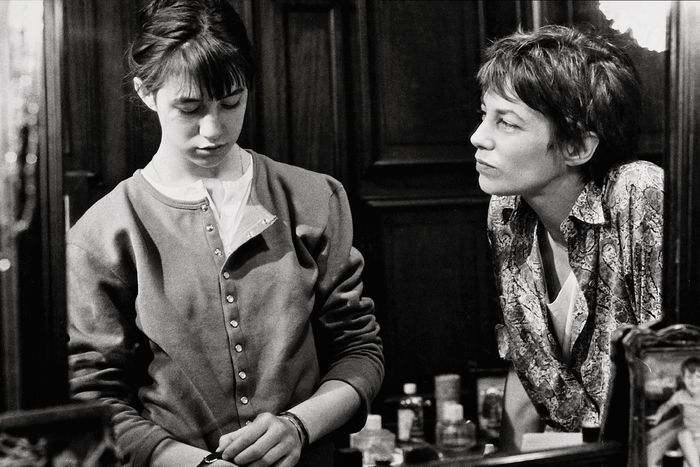
At some point in a woman’s journey to either become, or avoid becoming, her own mother, she realizes that the person who raised her might have actually had good taste. For myself and a contingent of women I know whose mothers lived in New York in the 1980s and ’90s, this happened the moment we first tried on, and later stole for ourselves, our mothers’ agnès b. snap cardigans.
Created by the French fashion designer Agnès Troublé in 1979 (the “b.” was for Bourgois, her first husband), the snap cardigan is a uniquely French combination of bohemian ease and bourgeois austerity, a Chanel jacket meets a Champion hoodie meets a baby onesie. Agnès, who is now 78 and one of the richest self-made women in France, calls it “a child’s garment for grown-ups.” (The brand sizes it 0 to 4.)
Its origins were pragmatic. At the time, “I had long, curly hair, so I thought it would be nice to not take [my sweatshirt] off over my head,” Agnès (pronounced an-yes) tells me. So she got out a pair of scissors, cut it up the front, and voilà: her own update on the ’50s twinsets her mother and aunts used to wear. “Right away, I sketched this very simple, square shape,” she says. She then added roomy sleeves “to be able to raise your arms and kiss someone.” The 13 pearlescent snaps were inspired by 18th-century jackets on statues around her hometown of Versailles.
Decades on, the snap cardigan, an ageless, timeless wardrobe staple from New York to Tokyo to Paris, is having a comeback. The style, called “Le Classique,” is still sold in a variety of colors and priced at $185, though it costs more in cashmere or leather. Sales for “Le Classique” grew by 253 percent in 2019. “In the past year, we’ve started to have a different type of clientele,” says the Soho store’s manager, Maggie Nathan. Young people who “don’t know who agnès b. is” have found the brand.
Agnès has never advertised, but she understood influencers before anybody hashtagged, rolling with everyone from Jean-Michel Basquiat to Harmony Korine. In January, Chloë Sevigny announced her pregnancy on Instagram with a photo of her stomach bulging out from a snap cardigan. The photo was taken by director Jim Jarmusch, who told me he buys snap cardigans as gifts for all his female friends, for a 40th-anniversary exhibition on the sweater.
Made of a sturdy cotton fleece from Troyes, France, these snap cardigans tend to get better with age like a fine, machine-washable wine. So you really want a vintage one. It has become a pretentiously unpretentious micro status symbol passed down from mothers and cool aunts — either willingly or through a case of permanent “borrowing.” (“[My mom] doesn’t know I still have it, so maybe this should be anonymous,” said one friend who will remain nameless.) It’s neither trendy nor particularly flattering, but it signals something about you. “I can’t explain why, but I tend to get along with everyone who wears this cardigan,” says Audrey Gelman, founder of The Wing.
You don’t need cool parents to be part of the club. You can find vintage ones on eBay, Etsy, and Poshmark; many come from Japan, with 40 agnès b. retail sites in Tokyo. Fashion designer Mike Eckhaus found his first snap cardigan at a thrift store in Hudson a few years ago. He liked it so much that he designed his own iterations for Eckhaus Latta, calling one with a curved row of snaps “agnès b. on acid.”
“Now, I see people wearing it everywhere,” says illustrator Joana Avillez, who inherited one from her grandmother and owns about a dozen. (\Eckhaus calls her the “snap cardigan icon” of today.
My own mother — who, not to brag, moved to Soho in the early ’80s — bought her first black snap cardigan at the Prince Street store simply because it looked comfortable. Coincidentally, her best friend also bought one. “Do they still sell it?,” Mom asks when I tell her about this article. After 25 years, she lost hers to a spill, so I had to buy my own.
For my generation, the snap cardigan is an anchor to an idea of the past, specifically a time in New York when ordinary people, places, and things were free from overwrought mythologies. Most important, it’s not fashion. As a friend of a snap-cardigan-wearing friend, Elena Tarchi, age 28, tells me, “I get fed Instagram ads for every new brand on the planet, but all I want is another snap cardigan.”
*This article appears in the March 2, 2020, issue of New York Magazine. Subscribe Now!
More From the spring 2020 fashion issue
- Our Favorite Spring Runway Looks, Reimagined As Candles
- The Fashion Industry’s Librarians of Luxury
- Needles, Diamonds, Smoke, and Bruising


